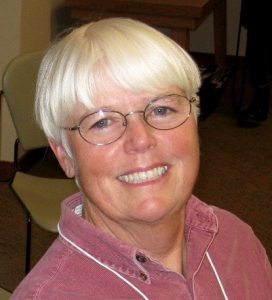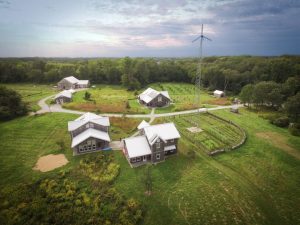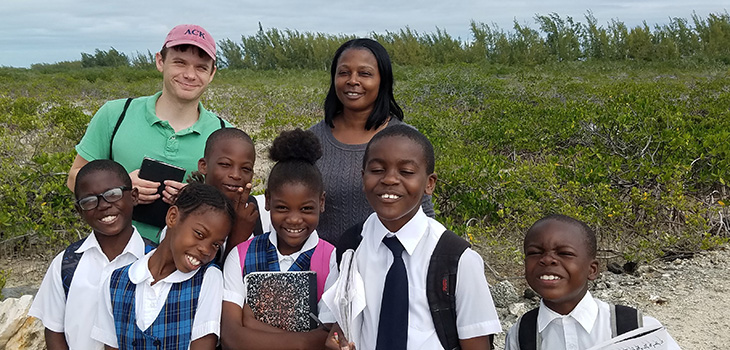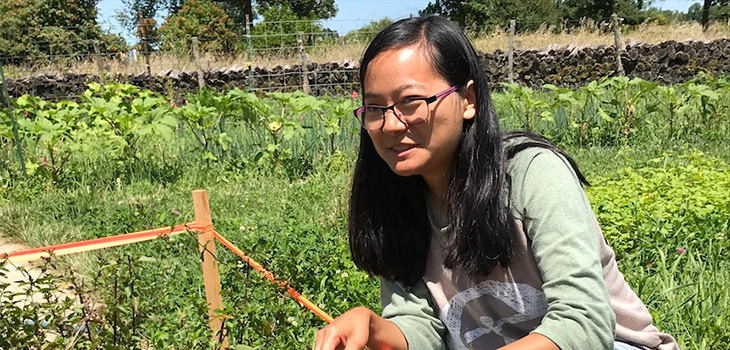If you start your hike at the Learning Center and go straight on the gravel road toward the Onion Bottom wetland, you’ll pass through the Holy Cow Swamp. This isn’t an official name of course, but the story of Mary Linton yelling “Holy cow!” as she unexpectedly plunged in its depths gets retold at Merry Lea every so often.
Mary Linton, a former Goshen College biology professor from 1989-2002, frequented Merry Lea’s wetlands and woods for class fieldwork and research projects. She largely conducted research on salamanders, trapping and tracking these species and studying how seasonal water levels affected populations’ movements. Thus, tromping through Merry Lea’s marshes and swamps with chest waders or muck boots were normal activities for Linton.
Historically, Indiana Department of Natural Resources (DNR) created waterfowl habitat by using dynamite to blast holes in low lying areas to be filled with rainwater. Decades ago, this practice was done at Merry Lea by DNR biologists. And during a routine survey of a brush-filled wetland with students, Linton discovered one such hole. Wading through the swamp her footing suddenly dropped, and Linton exclaimed, “Holy cow!!” as she floundered her way to a splashing recovery.
Thus, this temporary wetland area north of the Learning Center was dubbed the infamous Holy Cow Swamp.
It is a story that elicits at least a sly smile if not laughs from Merry Lea staff who heard it from Linton herself. But those full smiles and joyful expressions only scratch the surface for those who learned from, worked with, laughed with, taught with or were friends with Linton.

Mary Linton died June 13, 2021 at 66 years old, and in homage to her legacy, Merry Lea is officially renaming the Holy Cow Swamp to the Linton Swamp.
Linton established a bridge between Goshen College and Merry Lea that still exists today. When Linton was hired at Goshen College, she independently took the initiative to connect with Merry Lea. Not only was she the college’s first female biology professor, but also was the first to regularly conduct classes and fieldwork at Merry Lea. Her wetland ecological interests coincided well with what the nature preserve provided.
Dave Miller overlapped with Linton as Merry Lea program director, where he supervised the Lindsey Fellowship research program. This fellowship historically funded individuals who worked with education programs at Merry Lea. However, Miller and Merry Lea staff redefined the position to help fund a Goshen College biology faculty member to conduct ecological research at the preserve in addition to teaching on campus. They offered the position to Linton, who became the first Lindsey Fellow as it appears today. Goshen College Biology Professors Ryan Sensenig and Andy Ammons are current Lindsey Fellows.
Miller credits Linton as a liaison spanning the physical distance between Merry Lea and the college, including the challenges that distance bred. “She was well respected on campus, and I know her work here was important as a step along the way” in developing relationships and furthering Merry Lea’s research and collegiate programs.
Because of her initiative, she became a conduit for immersing undergraduate students in Merry Lea’s habitats to appreciate the intrinsic value of nature. “She set up the model of connecting students in an academic field setting at Merry Lea. She set the tone,” said Bill Minter, Merry Lea’s land manager.
INNOVATIVE MENTOR AND ROLE MODEL
During an overnight field excursion, Linton led students on the trails with her Walkman. Under the blanket of night, she played cassette tapes of owl calls, eliciting responses from live owls swooping in, creating a feeling of “being part of the ecosystems,” described a former student of Linton’s, Andrew Gascho Landis.
Linton taught by “creating experiences for students to make their own discoveries,” said Gascho Landis, who is now an environmental science professor at State University of New York Cobleskill.
Carol Good-Elliott, longtime Merry Lea environmental educator, studied biology at Goshen College. During her senior year, the college announced the addition of an environmental studies minor, so she stayed on a fifth year to take the new courses. That same year, Linton was hired as the biology department’s field ecologist.
“[Linton] made me excited about biology in a different way,” said Good-Elliott. During her time as Linton’s student, Good-Elliott was invited to conduct macroinvertebrate research at Sleeping Bear Dunes. “She was so enthusiastic about whatever she was finding, enthusiastic about pulling on chest waders and going into 33-degree water to look at these critters” in the middle of winter, chuckled Good-Elliott.
This same enthusiasm for nature is a repeated motif from all who described their interactions with Linton.
Like rushing to embrace an old friend once separated by space and time, Linton’s joy and wonder never wavered as she greeted salamanders, mosses and dragonfly nymphs anew, extending a warm welcome to these old and new friends. On bended knee and hand lens held to her eye, she humbly introduced students to the hidden intricacies of their backyard’s biodiversity.
“Her ability to pull students in was unparalleled,” Gascho Landis remarked with admiration. “As I reflect on…my own teaching, she had the ability to create a sense of wonder that I haven’t seen in many other instructors and sometimes have a hard time emulating myself.”
But Linton did more than introduce her classes to ecological fieldwork. “Mary was an innovative professor at the time,” said Suzanne Beyeler, a former student and environmental studies program director and assistant biology professor at Manchester University. Linton assigned creative arts projects in her biology classes like writing, poetry or artwork. This embodiment of the liberal arts resonated with students like Beyeler who see how communicating, writing, creativity, problem solving, and the power of music have “been critical at how effective I’ve been as a scientist.” “She bridged those two worlds well,” showing how all the arts fit into science. In direct correlation, Gascho Landis now assigns similar creative arts projects in the environmental science classes he teaches.
LOVER OF LIFE
 This affinity for the arts stemmed from Linton’s own personal “artistic streak,” according to Miller. A poet herself, her humor came through in her written works, according to those who had the privilege of reading her poetry.
This affinity for the arts stemmed from Linton’s own personal “artistic streak,” according to Miller. A poet herself, her humor came through in her written works, according to those who had the privilege of reading her poetry.
“She was very witty, had a very ready laugh and made other people laugh easily with her,” reflected Miller. Her humor permeated her lectures and work, putting on what Beyeler called, “a show.” This willingness and readiness to laugh are the reasons why the Holy Cow Swamp is a well-known story.
Linton created a life-giving environment that cultivated a space for students to be themselves and learn from their mistakes with grace. Colleagues noticed this respectful approach to all her students. “In the way she interacted [and] communicated to the students, it said, ‘I genuinely care about you.’ That was Mary always,” said Larry Yoder, former Merry Lea executive director.
She was also concerned “for the spiritual development and the spiritual wellbeing of her students,” said Yoder. She didn’t let enrollment or pressures of career ladders overshadow the importance of attending to the holistic aspect of students’ lives, another intersection of bringing the arts into the sciences. But of equal importance, Yoder described how Linton walked the walk of being a “fellow traveler” in her exploration and wonder of the biological world with a “spiritual artistic” humility.
Through – not despite – all these philosophies and heavy topics, Linton let her curiosity and humor exude as “a willingness to have fun and be playful in her work,” described Good-Elliott. “A lover of life,” said Miller. “That’s her.”
RIPPLING LEGACIES
 Although Linton took the initiative to bring students to Merry Lea, no lodging facilities existed at the time, so groups would sleep at nearby Bear Lake Camp. Thus, she provided the incentive for Merry Lea to establish an ecological field station. “She was a key person that was kind of the seed of what would be Rieth Village,” according to Minter.
Although Linton took the initiative to bring students to Merry Lea, no lodging facilities existed at the time, so groups would sleep at nearby Bear Lake Camp. Thus, she provided the incentive for Merry Lea to establish an ecological field station. “She was a key person that was kind of the seed of what would be Rieth Village,” according to Minter.
As Merry Lea commenced its strategic planning process under former Executive Director Luke Gascho in the late 90s, the team identified a vision for designing more collegiate field coursework and opportunities. Linton’s “leadership in terms of conversation [and] how she structured courses for inquiry and hands-on learning was significant for our planning process,” described Gascho.
With Merry Lea’s ability to provide quality undergraduate instructors, Linton created the curriculum for designing an environmental studies major while Gascho worked on the administrative details. This major came to fruition in 1999. And Linton’s impetus for utilizing Merry Lea as a rich resource led to the development of onsite, environmentally friendly student residences: Rieth Village.
In retrospect, it is easy to see how the threads of Merry Lea’s projects have spread far, eventually to be stitched together in a stronger, seamless mission. The evolution of Rieth Village as a collegiate facility and the hope of hosting environmental courses at Merry Lea, harken back to Merry Lea’s founders Mary Jane and Lee Rieth’s vision for the nature center. Even with different leaders influencing the projects, it is encouraging to see them woven into a mission-centered cloth that has weathered the test of time.
Arguably even more impactful than Linton’s contribution to the creation of Rieth Village and the environmental studies major, was her deep and powerful influence upon individual students.
“She was my academic advisor and mentor, but it was much more than that. She helped me shape my worldview on issues related to social and environmental justice,” said Gascho Landis. Linton helped students develop ethical frameworks for becoming collaborative and community-centric scientists. Beyeler and others learned from Linton how to be stewards of the earth – tending both the human and nonhuman world. Likewise, Linton conveyed the responsibility of scientists to communicate about their restorative work in an unpretentious and accessible way.
Carol expressed how “her being female was really important. I grew up in a family with a lot of strong female role models, but I wasn’t seeing that or experiencing it in the field of work I was interested in doing…And the fact that my professor was a woman doing that kind of leadership helped me think about possible [career] options in different ways.”
This type of empowerment was echoed by Beyeler. “When you can see someone like you doing something, you can more easily see yourself doing it.” Beyeler remarked that “Mary was a female field ecologist at a time when so few women were doing that,” and as a result of Linton’s encouragement and influence, the majority of Suzanne’s female peers interested in field ecology at Goshen College went on to achieve Ph.D.’s in ecology.
“She was THE reason I went to grad school.” During her last semester of senior year, Beyeler was sitting outside Goshen College’s Harold & Wilma Good Library, when Linton strolled by. Without any chit chat, Linton just walked up to Beyeler and asked, “Where are you going to grad school?” Beyeler had time to get in a “What?” before Linton continued walking. The fact that Linton expectantly asked where Beyeler had applied and not if, made Beyeler start submitting applications. “Mary thought I should apply, so I did when I didn’t think I could [at first].”
Linton also believed Gascho Landis was a professor the world needed. While visiting Goshen, Ind. years after graduating, Gascho Landis met up with Linton and her wife for dinner at their house. He expressed to Linton how he wasn’t sure whether or not to pursue a Ph.D. as he became disillusioned with academic life. That’s when Linton directly said, “We need more professors like you.” That moment was pivotal for him, being pointedly told by someone he admired that he would be a great professor. In retelling that scene, Gascho Landis paused to embrace the fullness of that moment with a flood of emotions that touched on gratitude, power and poignance. We are all but many moments put together leading us on meandering trajectories, and it is apparent from her mentees that it was a privilege to have Linton nudge along the way.
If she hadn’t stopped a student by the library and asked that blunt question or set the precedent for immersing students at Merry Lea, the ripples of environmentalism would look quite different in many lives.
And in a moment of vulnerability, it’s easy to be left feeling a little breathless by the impact of this one woman and her legacy. But in the spirit of Mary Linton, even if your footing in life has taken unexpected turns, the Merry Lea team hopes to inspire participants to exclaim “Holy cow!” at the new and old friends they meet in nature with renewed joy and wonder.



